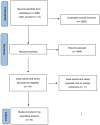Emerging Non-Breast Implant-Associated Lymphomas: A Systematic Review
- PMID: 39682271
- PMCID: PMC11640267
- DOI: 10.3390/cancers16234085
Emerging Non-Breast Implant-Associated Lymphomas: A Systematic Review
Abstract
Background: Medical devices used for functional or esthetic purposes improve health and quality of life; however, they are not risk-free. Anaplastic large-cell lymphoma (ALCL), associated with breast implants, is a well-known and recognized distinct lymphoma entity. More recently, additional lymphomas have been reported in relation to prosthesis other than breast implants, as these allow the pericyte to develop into a clone that undergoes a maturation process, progressing toward full malignancy. Methods: We performed a systematic review with a descriptive analysis of data extracted from primary studies following PRISMA guidelines, including the search string "(IMPLANT* OR PROSTHES*) AND LYMPHOM*" in the PubMed, Scopus, Embase, and Google-Scholar databases. Data such as patient sex, age, implant site, prosthesis material, and lymphoma type were analyzed. Statistical methods, including Student's t-test and Fisher's exact test, were employed to compare lymphoma characteristics, with significance set at a p-value < 0.05. Results: From a total of 5992 studies, we obtained 43 case reports and series on a total of 52 patients diagnosed with prosthesis-associated lymphomas. The majority of implant-related lymphoma cases (85%) were of the B-cell type, mostly fibrin-associated large B-cell lymphoma (LBCL). This lymphoma type was more associated with biological (non-human-derived biological tissue), metallic, and synthetic implants (synthesized from non-organic components) (p-value = 0.007). Patients with ALCL had equal frequencies of metal and silicone prostheses (37.5%, 3 cases each), followed by synthetic prostheses (25%, 2 cases). ALCL cases were most common at skeletal (50%) and muscular-cutaneous sites (25%), whereas B-cell lymphomas were predominantly found in cardiovascular implants (50%), followed by skeletal (27%) and muscular-cutaneous (21%) sites. Death attributed to lymphoma took place in 67% of the cases, mostly LBCL occurring in cardiovascular sites. Conclusions: Because the included studies were limited to case reports and series, a potential non-causal link might have been documented between different implant materials, implant sites and lymphoma types. This underscores the importance of further comprehensive research and monitoring of non-breast implants.
Keywords: anaplastic large-cell lymphoma; emerging lymphomas; fibrin-associated large B-cell lymphoma; implants; medical devices.
Conflict of interest statement
The authors declare no conflicts of interest. The funders had no role in the design of the study; in the collection, analyses, or interpretation of the data; in the writing of the manuscript; or in the decision to publish the results.
Figures




References
-
- 25 Most Common Prosthetics by Claims Volume. [(accessed on 7 October 2024)]. Available online: https://www.definitivehc.com/resources/healthcare-insights/most-common-p....
Publication types
LinkOut - more resources
Full Text Sources

